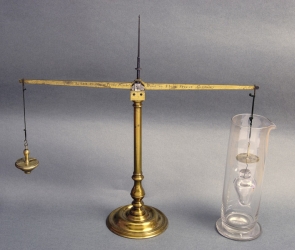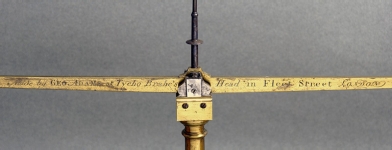Scientific Instrument Society 25th Anniversary Exhibition
Navigation:
<< First | < Previous | Next > | Last >>
42 Hydrostatic Balance
I liked the elegance of these scales and the combination of brass and glass.
Private Collection, West Midlands, U.K.
This balance was used to determine the specific gravity of solids by weighing the samples in air and water. It is engraved on the beam ‘Made by GEO ADAMS at Tycho Brahe’s Head in Fleet Street London’. It was described in 1704 by John Harris (1666-1719) in his Lexicon Technicum, or Universal Dictionary of Arts and Sciences, the first dictionary of science in English.
George Adams Snr. (1709-1772) moved to Fleet Street in 1760 and his premises were given the number 60 in July 1766.
In 1761 he made a series of drawings of instruments that he was making for King George III. The drawings, as well as many of the instruments, have survived and clearly show mechanical apparatus with beams of this form and the examen (pointers) are of exactly this shape.
English ca.1760. Note that the beaker is later.
See: Science Museum Library, MS 204, Plate 16.
P.D.
Objects lent by Anonymous Lender II, West Midlands, UK:
04. Beam Compass, by George Adams, London, 1757-60
13. Waywiser, by George Adams jr, London, between 1784 and 1796
35. Silver Engine-Turned Box Sextant, by Troughton, London, c. 1810
37. Sextant, by Jesse Ramsden, London, c.1765
50. Three Early Forms of Electro-Magnetic Demonstration Motor, English, c. 1835-40


